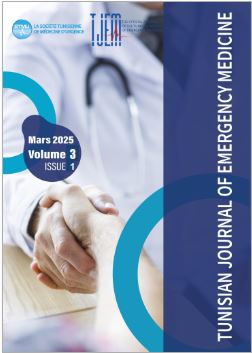The challenge in diagnosing human rabies: A case report
DOI:
https://doi.org/10.0000/j65pn511Keywords:
Encephalitis, Rabies, Diagnosis, ChallengeAbstract
Abstract
IntroductionRabies is a zoonotic disease caused by a neurotropic virus of the Lyssavirus genus. Human rabies can manifest in either encephalitic (furious) or paralytic (dumb) forms. The diagnosis is still challenging and often delayed. Viral infection must be considered and treated soon after viral transmission; failure to diagnose and intervene will usually result in disease progression and death.
Case presentationWe report a case of a 61-year-old female, with no past medical history, who visited the Emergency Department (ED) initially for sleep disorders, restlessness, anxiety, refusal of food and watery disgust. The investigations were normal, and the patient was discharged with symptomatic treatment. Her condition worsened after 24 hours, and she presented a cardiac arrest. After resuscitation and return of spontaneous circulation, her physical exam was without abnormalities. Laboratory exams and imaging investigations were normal. The diagnosis was a severe septic shock, treated with empirical antibiotics. A multiple organ failure syndrome has rapidly appeared, and the outcome was fatal.
Upon re-interviewing the family, it turned out that the patient was raising around 20 cats and that she was a victim of an accidental bite by one of her cats 3 weeks before admission. No medical advice was sought, and the family reported a completely healed wound. The patient did not receive any vaccination or serotherapy. Rabies serology came back positive. The diagnosis was confirmed after brain biopsy.
ConclusionHuman rabies is a challenging disease, with a complex neuropathogenic mechanism. The infection can be treated after recognized exposures. However, medical management, once the clinical disease develops, has almost universally proved to be unsuccessful, resulting in fatal outcomes.
Downloads
Published
Issue
Section
License
Copyright (c) 2025 Tunisian Journal of Emergency Medicine

This work is licensed under a Creative Commons Attribution-NonCommercial-ShareAlike 4.0 International License.
How to Cite
Similar Articles
- Samia Meherzi, Rihab Omri, Amin khbou , Rabiaa Kaddechi , Afifa CHARFI, Management of Bell palsy: our clinical practice guideline , Tunisian Journal of Emergency Medicine: Vol. 3 No. 1 (2025): TJEM 2025: Vol.3 Issue 1
- Haifa BRADAÏ, Rabeb Mbarek, Sondes Laajimi, Dorra Loghmari, Mounir NAIJA, Atrial flutter mimicking ST-elevation myocardial infarction: A case report , Tunisian Journal of Emergency Medicine: Vol. 3 No. 1 (2025): TJEM 2025: Vol.3 Issue 1
- safia othmani, Ischemic acute cholecystitis: a case report , Tunisian Journal of Emergency Medicine: Vol. 2 No. 4 (2024): TJEM Vol2 Issue4
- Sondes laajimi, haifa bradai, Nabil Chebbi, Dorra Loghmari , imen EL KISSI, Naoufel Chebili , rabeb Mbarek, Specific Features of Chest Pain in Young People treated in Prehospital Care , Tunisian Journal of Emergency Medicine: Vol. 3 No. 1 (2025): TJEM 2025: Vol.3 Issue 1
- Neila MAAROUFI, Youssef Zouaghi, Khaoula Amdouni, Sabra Ouaz, Beligh Oueslati, Moufida Nouari, Beyond the Rash: The Fatal Consequences of Lyell Syndrome , Tunisian Journal of Emergency Medicine: Vol. 3 No. 2 (2025): TJEM 2025: Vol.3 Issue 2
- Wiem Feki, Fatma Hammami, Amina Kammoun, Makram Koubaa, Mounir Ben Jemaa, Zaineb Mnif, Emphysematous pyelonephritis with infected abdominal aorta pseudoaneurysm among a diabetic man , Tunisian Journal of Emergency Medicine: Vol. 3 No. 2 (2025): TJEM 2025: Vol.3 Issue 2
- Faiza Safi, Traditional Medicine with Cade Oil in Pediatric Emergency Care , Tunisian Journal of Emergency Medicine: Vol. 2 No. 4 (2024): TJEM Vol2 Issue4
- Cyrine KOURAICHI, Value of inferior vena cava diameter respiratory change as a marker of heart failure in COPD exacerbation , Tunisian Journal of Emergency Medicine: Vol. 2 No. 2 (2022): TJEM Vol2 Issue2
- Sondes laajimi, Asma Ben Cheikh, Haifa Bradai, Nabil Chebbi, Salem Mefteh, Sonia Chouchène, Naoufel Chebili , Dorra Loghmari , Rabeb Mbarek, The Long-Term Somatic and Psychological Impact of Post-COVID Experience on Infected Patients , Tunisian Journal of Emergency Medicine: Vol. 3 No. 2 (2025): TJEM 2025: Vol.3 Issue 2
- Sarra Akkari , Emna Rachdi , Jalila Ben Khlil , Prognosis in COVID-19: Impact of Pre-hospital Emergency Care , Tunisian Journal of Emergency Medicine: Vol. 2 No. 4 (2024): TJEM Vol2 Issue4
You may also start an advanced similarity search for this article.
Most read articles by the same author(s)
- Amira Sghaier, Marwa Toumia, Khaoula Bel Haj Ali, Adel Sekma, Kaouthar Beltaief, Zied Mezgar, Wahid Bouida, Riadh Boukef, Jamel Saad, Hamdi Boubaker, Mohamed Amine Msolli, Mohamed Habib Grissa, Semir Nouira, B-lines Ultrasonography Assessment by Nurses for the Diagnosis of Heart Failure in the Emergency Department , Tunisian Journal of Emergency Medicine: Vol. 2 No. 4 (2024): TJEM Vol2 Issue4
- Rabeb Mbarek, Khouloud Hamdi, Sarra Soua, Hela Abroug, Sondes laajimi, haifa Bradai, Dorra Loghmari , Asma SRIHA, Semir Nouira, Prehospital Particularities of Covid-19 infection and factors associated with its severity during the omicron variant wave (East-center of Tunisia) , Tunisian Journal of Emergency Medicine: Vol. 2 No. 4 (2024): TJEM Vol2 Issue4
- randa dhaoui, A complicated pulmonary hydatid cyst mimickingpneumonia: A case report , Tunisian Journal of Emergency Medicine: Vol. 2 No. 4 (2024): TJEM Vol2 Issue4

